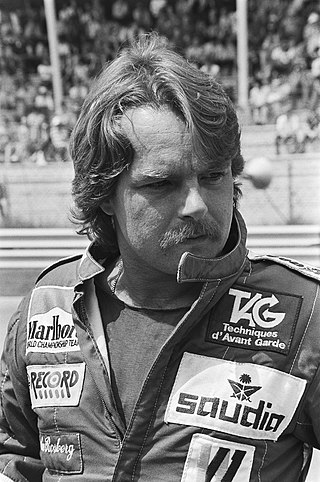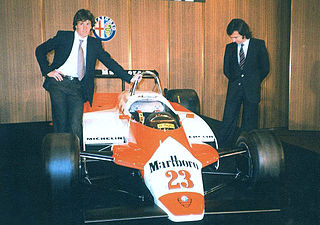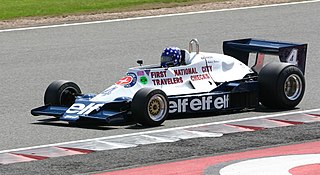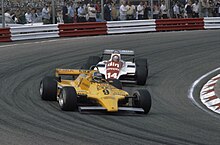Motor Racing Developments Ltd., commonly known as Brabham, was a British racing car manufacturer and Formula One racing team. It was founded in 1960 by the Australian driver Jack Brabham and the British-Australian designer Ron Tauranac. The team had a successful thirty-year history, winning four FIA Formula One Drivers' and two Constructors' World Championships, starting with two successive wins in 1966 and 1967. Jack Brabham's 1966 Drivers' Championship remains the only such achievement using a car bearing the driver's own name.

BMW has been involved in Formula One in a number of capacities since the inauguration of the World Drivers' Championship in 1950. The company entered occasional races in the 1950s and 1960s, before building the BMW M12/13 inline-four turbocharged engine in the 1980s. This engine was the result of a deal between BMW and Brabham, which resulted in the team's chassis being powered by BMW engines from 1982 until 1987, a period in which Nelson Piquet won the 1983 championship driving a Brabham BT52-BMW. BMW also supplied the M12/13 on a customer basis to the ATS, Arrows, Benetton and Ligier teams during this period, with various degrees of success. In 1988, Brabham temporarily withdrew from the sport and BMW withdrew its official backing from the engines, which were still used by the Arrows team under the Megatron badge. Turbocharged engines were banned by the revised Formula One Technical Regulations for 1989, rendering the M12/13 obsolete.

The 1982 FIA Formula One World Championship was the 36th season of FIA Formula One motor racing. It included two competitions run over the course of the year, the 33rd Formula One World Championship for Drivers and the 25th Formula One World Championship for Constructors. The season featured sixteen rounds between 23 January and 25 September. The Drivers' Championship was won by Keke Rosberg and the Constructors' Championship by Scuderia Ferrari.

Bruno Giacomelli is a retired racing driver from Italy.
ATS is a German company that manufactures alloy wheels for road and racing cars. It is based in Bad Dürkheim near the Hockenheimring race circuit. ATS had a Formula One racing team that was active from 1977 to 1984.

The Lotus 49 was a Formula One racing car designed by Colin Chapman and Maurice Philippe for the 1967 F1 season. It was designed around the Cosworth DFV engine that would power most of the Formula One grid through the 1970s. It was one of the first F1 cars to use a stressed member engine combined with a monocoque to reduce weight, with other teams adopting the concept after its success. An iteration of it, the 49B, also pioneered the use of aerofoils to generate downforce.

The Brabham BT49 is a Formula One racing car designed by South African Gordon Murray for the British Brabham team. The BT49 competed in the 1979 to 1982 Formula One World Championships and was used by Brazilian driver Nelson Piquet to win his first World Championship in 1981.

The McLaren MP4/1 was a Formula One racing car produced by the McLaren team. It was used during the 1981, 1982 and 1983 seasons. It was the second Formula One car to use a monocoque chassis wholly manufactured from carbon fibre composite, after the Lotus 88, a concept which is now ubiquitous. The MP4 was first entered in a Formula One race at the third Grand Prix of the 1981 season in Argentina.

The McLaren M7A and its M7B, M7C and M7D variants were Formula One racing cars, built by McLaren and used in the world championship between 1968 and 1971. After two relatively unsuccessful years of Formula One competition, the M7A was used to score McLaren's first win at the 1968 Belgian Grand Prix.

The Arrows A2 was a Formula One racing car, designed by Tony Southgate and Dave Wass, was used by the Arrows team in the latter half of the 1979 Formula One season. Powered by a Cosworth DFV V8 engine and driven by Riccardo Patrese and Jochen Mass, it was relatively unsuccessful with its best finish being sixth on two occasions.

The Tyrrell 011 was a Formula One car designed by Maurice Philippe for the Tyrrell Racing Organisation.

The Brabham BT50 was a Formula One racing car designed by Gordon Murray and powered by a turbo BMW engine. It was raced by the Brabham team, owned by Bernie Ecclestone, during the 1982 Formula One season. Driven by Nelson Piquet and Riccardo Patrese, it made its debut at the South African Grand Prix before being withdrawn for further development of its engine while the team reverted to the previous year's car, the Brabham BT49. On the reintroduction of the BT50, Piquet finished fifth in the Belgian Grand Prix. A few races later he drove it to a win in the Canadian Grand Prix. Later in the year it achieved three more finishes in the points for the team. During the second half of the season, Brabham implemented the strategy of mid-race refueling. This allowed Piquet and Patrese to start the races relatively light and use their reduced weight to gain track position over their competitors before stopping to refuel. The poor reliability of the BT50 meant that they had only a few opportunities to demonstrate the strategy in practice.

The Shadow DN1 was a Formula One car used by the Shadow team during the 1973 Formula One season and the early stages of the following season. The car was the first Formula One car for Shadow, which had previously participated in the CanAm Sportscar Series. It was designed by former BRM engineer Tony Southgate. The DN1 was also driven by Graham Hill for his privateer team, Embassy Hill.
The Ligier JS21 was a Formula One racing car manufactured and raced by Ligier during the 1983 Formula One season. Powered by a Cosworth V8 engine while the majority of teams used turbo power, the team failed to score any points.

The ATS D6 was a Formula One racing car manufactured and raced by the Team ATS during the 1983 Formula One season. It was powered by the BMW M12/13 4-cylinder turbocharged engine but the team failed to score any points.

The ATS D2 was a Formula One racing car manufactured and raced by the ATS Wheels racing team for most of the 1979 Formula One season. It was powered by a Cosworth DFV V8 engine. Driven by Hans-Joachim Stuck, the D2 failed to finish any races in the points. It was superseded by the ATS D3 from the Austrian Grand Prix.
The ATS D1 was a Formula One racing car manufactured and raced by the ATS Racing Team for the last two races of the 1978 Formula One season. It was powered by a Cosworth DFV V8 engine. Driven by Keke Rosberg, the D1 failed to finish any races in the points.
The Rial ARC2 was a Formula One racing car manufactured and raced by Rial Racing for the 1989 Formula One season. It was powered by a Cosworth DFR V8 engine. Its best finish was at the 1989 United States Grand Prix when Christian Danner drove it to fourth place.

The Tyrrell 008 was a Formula One car manufactured and raced by the Tyrrell Racing Organisation team during the 1978 season. Driven by Didier Pironi and Patrick Depailler, it achieved several podium finishes including a win at the 1978 Monaco Grand Prix.

The March 811 is a Formula One car built by March Engineering and used by RAM Racing in the 1981 Formula One World Championship. Designed by Robin Herd, Gordon Coppuck, and Adrian Reynard, it was powered by the traditional 3.0 L (180 cu in) Ford-Cosworth DFV V8 engine. It initially used Michelin tyres, but eventually switched to Avon tyres at the 1981 French Grand Prix. It was March's first Formula One car since 1977.















